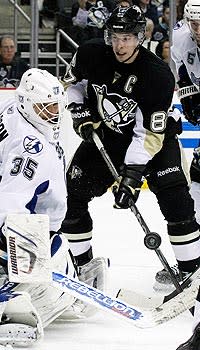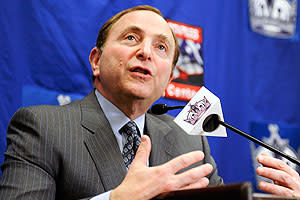NHL considers steps to get handle on head hits
BOCA RATON, Fla. – The conference room was quiet, clinical. The replay flashed on flat-screen televisions, muted. The only person who spoke was NHL vice-president of hockey operations Kris King, narrating the action on the screens Monday afternoon.
“January 1st,” King said.
It was the Winter Classic, the league’s annual outdoor game.
“The puck comes out of the zone,” King said. “Both players go to get it. One player turns one way, the other the other. Hits his head on the shoulder.”
One player was Pittsburgh Penguins captain Sidney Crosby(notes), the other David Steckel, then of the Washington Capitals.
“Player misses time because of a concussion,” King said.
Crosby hasn’t played since Jan. 5, when he took another hit, this one from behind by Tampa Bay Lightning defenseman Victor Hedman(notes). He has missed 29 games and counting. He finally returned to the ice for 15 minutes Monday morning, raising hopes he might play again this season, though there remains no timetable for his return.
“Inadvertent collision,” King said.
Next clip.
The Crosby-Steckel collision was just one of many plays King showed reporters covering the NHL general managers’ meetings at the Boca Beach Club, a ritzy resort by the Atlantic Ocean.
And it was just one of even more plays the league’s hockey operations department showed the GMs themselves earlier that morning, on the same screens in the center of the same circle of tables, about the same time Crosby went for his skate in Pittsburgh.
But it is that play more than any other that illustrates the layers of the concussion debate/dilemma facing league officials, as they study the issue under immense public pressure to address it further.
Had Crosby not gone down, would there be this much attention on concussions in the NHL? Is there any rule that could have prevented – or at least reduced the risk – of such an incident? Had doctors diagnosed a concussion after the Steckel hit, would Crosby have sat out Jan. 5? Would he not have been hit by Hedman, too?
Would he be back by now?
Crosby’s absence brought focus on player safety before Boston Bruins defenseman Zdeno Chara(notes) ran Montreal Canadiens winger Max Pacioretty(notes) into a stanchion last Tuesday night at Montreal’s Bell Centre – leaving Pacioretty with a concussion and fractured vertebra, earning Chara no fine or suspension which led to outrage from media, fans, sponsors and politicians.
This was the best player in the game, on pace for the best season of his career, concussed in the league’s showcase event. People inside and outside of the game have held up Crosby’s absence as the high cost of concussions and used it to argue for a ban on all hits to the head, whether intentional or unintentional.
“My position is there should be no head hits,” Penguins general manager Ray Shero said. “That’s the position of the Penguins, and that’s mine, and I brought it up today in our group.”
But the league has tried to take the emotion out of the equation and look at the cold, hard data. The hockey operations department studied all of the concussions suffered through March 1 and compared them to the same period last season, before Rule 48 was instituted to ban blindside hits to the head. Hockey ops showed the GMs video clips of virtually every concussion in the NHL this season and gave them statistics.
Crosby thought Steckel hit him intentionally. The league considered it incidental contact. Twenty-six percent of concussions though March 1 were from what the league labeled “accidental events” – teammates running into each other, players tripping on their own, pucks hitting players, inadvertent collisions of opponents. The number of accidental concussions doubled.
Asked after his skate Monday morning whether head shots should be banned, Crosby told reporters in Pittsburgh: “That’s a great question. I’d like to say yes. But it’s more than just saying that. There’s obviously got to be some clarity. Everything’s got to be looked at. It’s a pretty fast game. There may be times when guys maybe don’t (aim) for the head but come into contact with the head. What do you do in that situation?”
Crosby said banning deliberate head shots would take nothing from the game. Fourteen percent of all concussions through March 1 resulted from legal hits to the head. If you could cut that 14 percent, wouldn’t you do it? But Bettman called the legal hits to the head that some want outlawed “a small piece of the equation.” He said the data clearly show that no one thing caused concussions in the period studied and the actual reasons for the increase in the injury differ from the speculation.
Forty-four percent of concussions resulted from legal hits. One concussion was caused by a blindside hit – the one suffered by the St. Louis Blues’ David Perron(notes), who has been sidelined since he was struck Nov. 4 by the San Jose Sharks’ Joe Thornton(notes) – and there was no increase in the number of concussions caused by direct contact to an opponent’s head. In the written report, the word “no” was underlined.
“There is no magic bullet in dealing with this,” Bettman said. “I know it is an emotional, intense subject, especially for our fans. We understand it. We get it. But dealing with this issue is not something you can just do whimsically or emotionally. You really have to understand what is going on.”
The GMs will discuss a number of ideas before the meetings conclude Wednesday, such as tweaking penalties for boarding and charging. More than half of concussions resulting from a legal hit involved a secondary impact with the glass or boards.
Bettman outlined five steps the league would take to address player safety – reducing the size of some equipment, revising the return-to-play protocol, holding teams accountable for the actions of repeat offenders, hiring a safety engineer to evaluate rinks while requiring teams that use seamless glass to switch to Plexiglas, and forming a committee of accomplished former players to look at these issues.
The most significant of those steps might be the revision of the return-to-play protocol. Back to Crosby. The Penguins have maintained that the Hedman hit caused Crosby’s concussion. But after Crosby collided with Steckel at the end of the second period in Winter Classic, he seemed dazed.
Still, he played the third period that night. Still, he played against the Lightning four nights later. Shero said he saw Crosby at 4:30 p.m. before the Tampa Bay game and “it never occurred” to him that Crosby would have a concussion. But concussions symptoms are cognitive, not just physical. Had Crosby undergone testing, it might have occurred to a doctor.
Shero has experienced a similar situation with his 15-year-old son, Christopher, who suffered a concussion playing hockey this season – but didn’t stop playing until he took a second hit. While Crosby tried to skate again Monday, Christopher was trying to get through a full day of classes.
“I’m a super parent, I guess, because my son had a concussion about a month ago, and I let him play seven more games and practice five more times,” Shero said. “We didn’t know. So, as a parent, it’s frustrating.
“All these guys have parents. You’re dealing with lives and careers, a lot of things – my kid’s schooling. That’s part of this. As I’ve said before, when you’re talking about protocol for concussions, we’re evolving as a league. We’ve made strides since last year, and we’ll continue to make strides.”
But the strides Monday were the same for the GMs in that conference room in Boca Raton as they were for Crosby on the ice in Pittsburgh – slow and careful, deliberate and hopeful.


